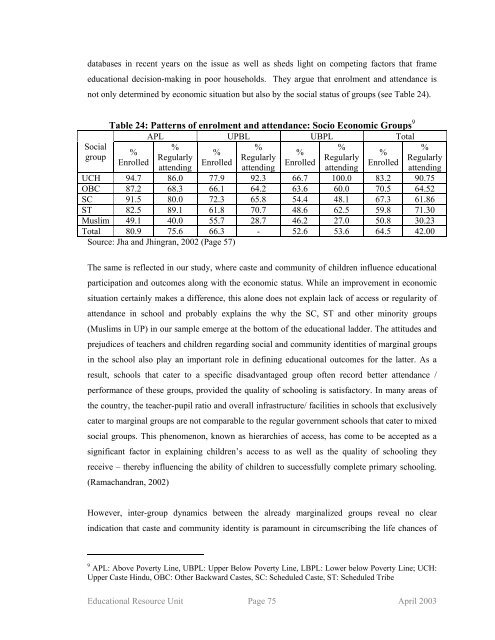Snakes and Ladders - ERU Consultants Pvt. Ltd.
Snakes and Ladders - ERU Consultants Pvt. Ltd.
Snakes and Ladders - ERU Consultants Pvt. Ltd.
Create successful ePaper yourself
Turn your PDF publications into a flip-book with our unique Google optimized e-Paper software.
databases in recent years on the issue as well as sheds light on competing factors that frame<br />
educational decision-making in poor households. They argue that enrolment <strong>and</strong> attendance is<br />
not only determined by economic situation but also by the social status of groups (see Table 24).<br />
Table 24: Patterns of enrolment <strong>and</strong> attendance: Socio Economic Groups 9<br />
APL UPBL UBPL Total<br />
Social<br />
group<br />
%<br />
Enrolled<br />
%<br />
Regularly<br />
attending<br />
%<br />
Enrolled<br />
%<br />
Regularly<br />
attending<br />
%<br />
Enrolled<br />
%<br />
Regularly<br />
attending<br />
%<br />
Enrolled<br />
%<br />
Regularly<br />
attending<br />
UCH 94.7 86.0 77.9 92.3 66.7 100.0 83.2 90.75<br />
OBC 87.2 68.3 66.1 64.2 63.6 60.0 70.5 64.52<br />
SC 91.5 80.0 72.3 65.8 54.4 48.1 67.3 61.86<br />
ST 82.5 89.1 61.8 70.7 48.6 62.5 59.8 71.30<br />
Muslim 49.1 40.0 55.7 28.7 46.2 27.0 50.8 30.23<br />
Total 80.9 75.6 66.3 - 52.6 53.6 64.5 42.00<br />
Source: Jha <strong>and</strong> Jhingran, 2002 (Page 57)<br />
The same is reflected in our study, where caste <strong>and</strong> community of children influence educational<br />
participation <strong>and</strong> outcomes along with the economic status. While an improvement in economic<br />
situation certainly makes a difference, this alone does not explain lack of access or regularity of<br />
attendance in school <strong>and</strong> probably explains the why the SC, ST <strong>and</strong> other minority groups<br />
(Muslims in UP) in our sample emerge at the bottom of the educational ladder. The attitudes <strong>and</strong><br />
prejudices of teachers <strong>and</strong> children regarding social <strong>and</strong> community identities of marginal groups<br />
in the school also play an important role in defining educational outcomes for the latter. As a<br />
result, schools that cater to a specific disadvantaged group often record better attendance /<br />
performance of these groups, provided the quality of schooling is satisfactory. In many areas of<br />
the country, the teacher-pupil ratio <strong>and</strong> overall infrastructure/ facilities in schools that exclusively<br />
cater to marginal groups are not comparable to the regular government schools that cater to mixed<br />
social groups. This phenomenon, known as hierarchies of access, has come to be accepted as a<br />
significant factor in explaining children’s access to as well as the quality of schooling they<br />
receive – thereby influencing the ability of children to successfully complete primary schooling.<br />
(Ramach<strong>and</strong>ran, 2002)<br />
However, inter-group dynamics between the already marginalized groups reveal no clear<br />
indication that caste <strong>and</strong> community identity is paramount in circumscribing the life chances of<br />
9 APL: Above Poverty Line, UBPL: Upper Below Poverty Line, LBPL: Lower below Poverty Line; UCH:<br />
Upper Caste Hindu, OBC: Other Backward Castes, SC: Scheduled Caste, ST: Scheduled Tribe<br />
Educational Resource Unit Page 75 April 2003












